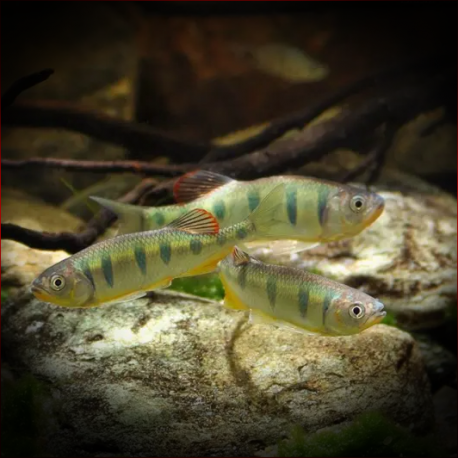More info
Datasheet
| Minimum Tank Size | 240 litres / 63.40 US gallons |
| Maximum Size | 10.0cm / 3.94inches |
| Temperature | 18°C / 64.40°F - 26°C / 78.80°F |
| Hardness | 2.02dgH / 36ppm - 12.05dgH / 215ppm |
| pH | 6.0-8.0 |
General Description
Opsarius Signicaudus, also known as the Sign-Tailed Barb, is a fish species that may have been misidentified when exported for aquarium trade due to its distinct caudal-fin base blotch shape and other unique characteristics. It belongs to the Cyprinidae family and can reach a maximum size of 10.0cm.
Aquarium Setup
The ideal tank setup for O. Signicaudus should mimic a flowing river environment with a substrate of rocks, sand, fine gravel, and some large boulders. Driftwood, roots, and branches can be added for decoration while leaving ample open swimming space. Hardy aquatic plants like Microsorum, Bolbitis, or Anubias spp. can be attached to decor. Proper filtration, aeration, and frequent water changes are crucial for this species, which requires spotless water conditions and high oxygen levels. A tightly-fitting tank cover is essential due to its jumping behavior.
Behaviour
O. Signicaudus is unsuitable for community tanks due to its environmental requirements and fast swimming behavior. It is a vigorous feeder that may outcompete or intimidate slower or smaller tankmates. This species should be kept in groups of five or more individuals to prevent aggression among subdominant fish.
Feeding and Diet
In the wild, O. Signicaudus primarily feeds on surface insects and small fishes. In captivity, they can be fed high-quality dried foods supplemented with live and frozen fare such as chironomid larvae, Artemia, and chopped earthworms. Gut-loaded Drosophila fruit flies and small crickets are also suitable food options.
Reproduction & Dimorphism
There is no recorded information on the reproduction of O. Signicaudus. Nuptial male individuals may develop an enlarged chest, more tubercules on the head, and a more intense coloration compared to females. Females tend to grow slightly larger and have a thicker body, especially when gravid.
Habitat and Distribution
This species is found in headwater tributaries of the Mae Klong River in western Thailand, inhabiting well-oxygenated, fast-moving rivers with substrates of gravel, cobbles, and boulders. Adult O. Signicaudus prefer deeper, flowing habitats, while juveniles occupy shallower waters or slower-flowing zones behind rocks.

